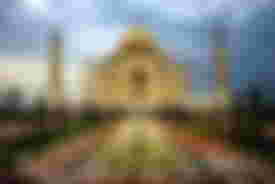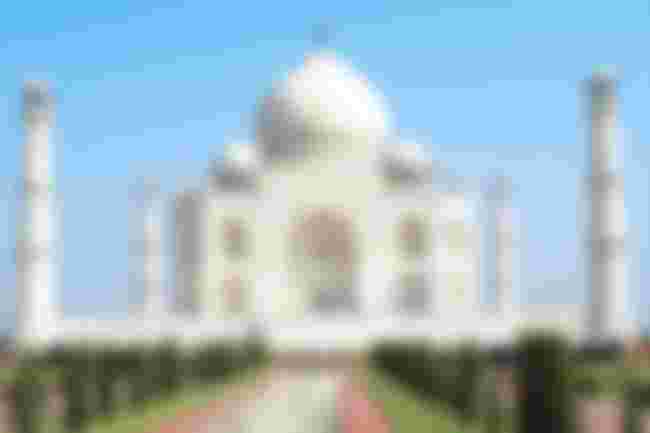



The Taj Mahal, one of the Seven Wonders of the World, was built in the seventeenth century by the Mughal emperor Shah Jahan to perpetuate the memory of his beloved wife Mamtaz Mahal. The architectural beauty of the Taj Mahal has been a wonder to people for centuries. At the root of so much pomp in the Taj Mahal is mourning, separation, lamentation.
Emperor Shah Jahan (ascended the throne of Delhi in 1726-1857 AD) was then at war with Khan Jahan Lodi at Burhanpur. The time is around 1831 AD. The news reached the emperor that Mumtaz might have a child. The birth of a child is imminent. Shahjahan reached Delhi in a hurry. On hearing the news of her husband's arrival, Mumtaz forgot all the customs and summoned her beloved husband, Emperor Shahjahan, to the palace. Mumtaz was in labor pains then. Tears of pain are falling in his eyes. The emperor's bewildered gaze was then fixed on Mumtaz's teary eyes. Mumtaz looked at her husband. Gestured to the emperor my mind saying, I may die shortly after childbirth. I have no hope of survival. I will leave all the illusions of this world and go to that land of immortality. O emperor, I have long been a partner in your joys and sorrows. I want to tell you the last thing on my mind before I leave. The emperor went closer to Mumtaz and sat down. The dying empress then gave birth to a child. Said my two wishes are the last word. Allah left in my womb 4 sons of yours namely- Dara Shiko, Shuja, Aurangzeb and Murad and 4 daughters Anjuman Ara Begum, Jinat Ara Begum, Jahanara Begum, newborn baby daughter Dhayer Ara Begum. These are enough to save the family. No matter how beautiful a woman is, no other woman has a child in her womb. And the second wish is to build a marble monument on my tomb after my death, which will be the source of incomparable beauty in this world. I left Ara Begum, a newborn baby girl. These are enough to save the family. No matter how beautiful a woman is, no other woman has a child in her womb. And the second wish is to build a marble monument on my tomb after my death, which will be the source of incomparable beauty in this world. I left Ara Begum, a newborn baby girl. These are enough to save the family. No matter how beautiful a woman is, no other woman has a child in her womb. And the second wish is to build a marble monument on my tomb after my death, which will be the source of incomparable beauty in this world.


Faced with death, Mumtaz expressed her last wish and left the world forever. The day was June 6, 1831 in the pages of history. Ara Begum, the daughter of a newborn baby, was left behind. It is said that the emperor mourned the loss of his wife and mourned at the royal court for two years. It is also heard that Emperor Shah Jahan became so obsessed with the show that in a few months his beard and hair turned pale. Mumtaz has been happily married to her husband Emperor Shahjahan for 19 years.
Emperor Shah Jahan was very eager to fulfill his wife's last wish. He decided to build a palace on the tomb of his dead wife whose fame would spread and people would remember the love of Shahjahan and Mumtaz forever when they saw him in the future. Who is this Shahjahan? And Mumtaz Mahal? One of the four sons of the famous Mughal emperor Jahangir, Khasru, Parvez, Shahjahan and Shahriar, Shahjahan was born on 5 January 1596 in Lahore. His childhood name was Khurram. His mother was Jagat Gosain, daughter of Rana Uday Singh of Mebar. He was very dear to his grandfather Mahamati Dillishwar, Jagadishwar, Akbar. From childhood he was agile, Intelligent and ambitious. When he was able to defeat Amber, the powerful owner of Ahmednagar, in 1817, his father, King Jahangir, was pleased and awarded him the title of Shahjahan World Emperor. Mumtaz Mahal was the only daughter of the powerful Mughal aristocracy Asaf Khan. He was born in 1593 AD. She married Yuvraj Khurram (Emperor Shahjahan) in 1612. The real name of the Persian princess Mamtaz Mahal is Arjumand Banu Begum. In history, Shahjahan's beloved queen Arjumand Banu Begum later came to be known as Mamtaz Mahal. This was the second marriage of Emperor Shah Jahan. In the old days, no woman with such a high status as Mumtaz Mahal has been able to achieve so much fame in history. Just as he loved the emperor wholeheartedly, so did the emperor love him sincerely and deeply. She married Yuvraj Khurram (Emperor Shahjahan) in AD. The real name of the Persian princess Mamtaz Mahal is Arjumand Banu Begum. In history, Shahjahan's beloved queen Arjumand Banu Begum later came to be known as Mamtaz Mahal. This was the second marriage of Emperor Shah Jahan. In the old days, no woman with such a high status as Mumtaz Mahal has been able to achieve so much fame in history. Just as he loved the emperor wholeheartedly, so did the emperor love him sincerely and deeply. She married Yuvraj Khurram (Emperor Shahjahan) in AD. The real name of the Persian princess Mamtaz Mahal is Arjumand Banu Begum. In history, Shahjahan's beloved queen Arjumand Banu Begum later came to be known as Mamtaz Mahal. This was the second marriage of Emperor Shah Jahan. In the old days, no woman with such a high status as Mumtaz Mahal has been able to achieve so much fame in history. Just as he loved the emperor wholeheartedly, so did the emperor love him sincerely and deeply. Not able. Just as he loved the emperor wholeheartedly, so did the emperor love him sincerely and deeply. Not able. Just as he loved the emperor wholeheartedly, so did the emperor love him sincerely and deeply.
So he set out to fulfill his wife's last wish. The beginning is a great activity. The result is the world's unique Taj Mahal. The construction of the Taj Mahal was not handed over immediately after Mumtaz's death. After his death, his tender body was kept at a place in Agra. After a long 9-month stay in a scientifically sound manner, the Taj Mahal is now brought to where it was built. For 9 months, the visionary emperor Shahjahan has made various models with the help of scholars from home and abroad. All the designs of the Taj Mahal were first made in wooden molds. The mold made by Afridi in Turkey was very much liked by all, including the emperor. In fact, the model was very much remembered by Emperor Shah Jahan, This wooden mini Taj Mahal. People came from all over the world to work. The Taj Mahal was built by people from outside India who were skilled in the sculpture industry. History has shown that a total of 15 architects have played an active role in the construction of the Taj Mahal.


Afridi and his fellow artist Md. Sharif came from Samarkand. Amir Ali and Roshan Khan came from Multan to decorate the flower garden. Abdullah came from Delhi and Mohammad Sajjan Khan from Balkh. Famous writer Amanat Khan came from Egypt. Then came Ellen Masonry's superintendent and director Mohammad Janaf Khan. Another writer from distant Baghdad was Mohammad Khan. Besides, Ismail Khan, Mohan Lal Mosari and Mina War Lal and Mohabbat Lal and Khatam Khan were brought from Lahore as experts in the work of the dome. All of them had a salary of five hundred to one thousand rupees at that time.
There are many marble architectural monuments in the world but no other marble architecture in the world has achieved the same fame as the Taj Mahal. For this, Emperor Shah Jahan had to spend many sleepless nights. The people of the emperor have searched all over the world in search of the best precious stones. Lots of white marble was brought from Makrana and Raiwala in Jaipur. The red sandstone was brought from Fatehpur Sikri. Also Baghdad, Yemen, Grand Tibet, Sinhala, Canada, South India, Nile River in Egypt, Ganges, Gwalior, Persia, Kumaon, Maharashtra, Jeheri, Makran, Khamach, Vindhyachal Mountains, Jabbalpur, Rajasthan, Himachal to Plains, Bengal Sand Island - Nothing left out of his sight. In all, 16,000 mana stones were collected. This is just a rough calculation of the marble stone. Coral pomegranate was brought from Arabia. The gem-like gem came from the bundle, The Padmaraga gem was brought from Persia (present day Iran). Besides, there were precious rubies in the Taj Mahal of Agra - 60 manas, emeralds - 100 manas, sapphire gems - 180 manas, bright gems made of various colors - 180 manas, turquoise gems - 90 manas, Gwalior Stone - 990 manas, bright diamonds. Magnetic iron ore (magnetic iron) - 60 ounces, another 230 ounces of precious gems and a gold bar without sugar was approximately 200 ounces. Three and a half hundred years ago today, Emperor Shah Jahan used to collect gold, diamonds, rubies, emeralds, gems and jewels and put them in the Taj Mahal to create beauty. And today we, the people of this age, consider ourselves blessed that we will return our destiny by wearing two or one Rati precious stone rings on our fingers. So it is a matter of absolute good fortune for any person to come in contact with the architectural masterpiece in which so many jewels are gathered. In the Taj Mahal philosophy, how attractive and artistic its form can be, It is not possible to guess without seeing with the eyes. Called the dream of historians in white marble, the architect of the world-famous Taj Mahal, the queen of this beautiful architecture, was Ustad Isa Khan, a resident of Istanbul, Turkey. Legend has it that the Taj Mahal is an alternative to any other monument that craftsmen cannot build; For this, two hands of the builders were cut off and their eyes were blinded. Mr. Vincent, a Christian writer, says: "The splendor of King Shahjahan, his love of architecture, the construction of palaces and forts, especially the Taj Mahal, have surprised many." But behind this luxury lies the ugliness of many cruel tortures and brutal murders. The Taj Mahal (1831-1853 AD) is one of the seventh wonders of the world called the Taj Mahal on the banks of the river Jamuna in Agra. ) Shahjahan is still immortal in history. At that time, one of the seventh wonders of the Taj Mahal of Agra (1831-1853 AD) was built by 20,000 artisans working day and night for 22 years to build this absolute memorial. Construction materials and gems were brought from all over India and Central Asia. And thousands of elephants were used to bring these materials. At that time, a total of 4 crore 12 lakh 50 thousand 6 hundred and 26 rupees was spent from the treasury of Emperor Shah Jahan in the Taj Mahal of Agra. Do those diamonds, rubies, emeralds still have flour on the Taj Mahal? On the night of the full moon, does the limb of the crown still shine as brightly as in the past? History does not say. The real pearl, The gold crown is no more. In the womb of time all has been plundered. It is rumored that Shah Jahan planned to build another Taj Mahal on the other side of the Jamuna. This crown of black stone was the emperor's own tomb. Emperor Shah Jahan also started the construction of this monument. But due to a dispute with the sons, it was no longer possible to make it. His son Aurangzeb, who was sitting on the throne, did not allow it to be built. Apart from the famous Taj Mahal in Agra, Emperor Shah Jahan, who is known as the father of architecture, has immortalized the works of art that have been immortalized in history. His notable achievements include Diwan-i-Khas and the establishment of the city of Shahjahanabad on the outskirts of Delhi. The reign of Emperor Shah Jahan was from 1626 AD to 1757 AD. Shah Jahan ascended the throne of Delhi on 8 February 1826.


The entrance to the Taj Mahal is made of red sandstone. It is about 100 feet high. The words of the Qur'an are inscribed in Arabic letters on the arch. The main tower, 18 feet high, covers an area of 60 feet in diameter. There are small minarets around the main minaret. Their height is 108 feet. And in the middle of the Taj Mahal is a locked house. Emperor Shahjahan and Mumtaz Mahal are sleeping here forever. Before, there was only Mumtaz's tomb. After the death of the emperor, he was also buried next to his wife. Since 1974, no one has been allowed to enter the main tomb. Another fake tomb of exactly the same type has been built on the floor above this tomb. Tourists get a chance to see this fake tomb.
The Taj Mahal was studded with innumerable gems. There was a chandelier inlaid in the minaret. The whole minaret was covered with 35 kinds of precious stones. Now they are not. Jat robbers looted. Later, Lord Curzon placed a bronze lantern. The Jats also opened the silver door of the entrance. Now there are brass doors. Even after so many loot scales, the Taj Mahal has not lost some of its splendor.
The structure of the Taj Mahal is very characteristic. It is said that the real beauty of the Taj cannot be seen in a hurry. To understand its beauty properly, one has to notice it in a very slow way. The Taj Mahal is built in a rectangular shape just like the way a beautiful woman is seen from all sides, so that when looking at the Taj Mahal, it feels as if I am looking at a beautiful woman. The main gate is also made much like the veil of a newly-wed bride on a rainy night. The veil must be removed slowly. As mentioned earlier, the main building is made of white marble. The open arrow of the Jamuna behind. As a result, the magic of light is created around the Taj Mahal. The Taj Mahal reflects the light of the sun and takes on different colors at different times of the day. Slightly reddish in the morning, milky white in the afternoon, And Taj seems to be golden in the moonlight. The whole Taj Mahal glows like pearls in the moonlight. Even in different seasons, different colors appear on the body of the crown. It is believed that the Taj Mahal is constantly changing color as a symbol of a woman's various mental states.


Everything would be incomplete without mentioning two things about the famous peacock throne of Emperor Shah Jahan in this article. Another famous example of Shah Jahan's love of art is the world famous peacock throne. He built it under the supervision of Bebadal Khan, an industrialist, from 1828 to 1835 at a cost of about Rs. It is surprising to think that Shah Jahan built this magnificent peacock throne at a cost of twice as much as the Taj Mahal in Agra at that time. It was gold, Inlaid with diamonds and rare emerald gems. The 4 legs of the throne were made of solid gold and the moonstone roof was covered with 12 emerald pillars. There were enamelled pearls around the roof. The inside was covered with precious rubies and emeralds. At the top of each pillar was placed a pair of peacocks inlaid with jewels, and in the center of each pair of peacocks was placed a mani-manikya tree in such a way that it looked as if the peacock was eating the fruit of the tree in two stalks. Many designs are made all over the throne and the space between the designs is decorated with small diamonds. There were three stairs decorated with diamonds and emeralds. Rows of pearls were placed in the four corners of the canopy above the throne. Beneath the canopy were also diamond and pearl designs. The tails of the peacocks, decorated with various jewels, were blue gems Made with One was placing a huge ruby on the peacock's chest. A 50-carat yellow pearl hung from there. Innumerable gems and pearls were adorned in different directions to support the throne. During the reign of Emperor Jahangir in 156 AD, His Majesty the Emperor of Persia, Abbas, presented a diamond worth Rs. 1 lakh to the then King. Emperor Shah Jahan also attached this father's diamond to the peacock throne. There are two facts about the construction cost of this peacock throne - in the past it cost Rs 6 crore. Which has already been mentioned in this article. On the other hand, Tavernier, a European tourist at the time, mentioned that the cost of the jewel-encrusted throne was Rs 5 crore, diamond-pearl emerald, jewelery worth Rs 90 lakh. Gold worth Rs 20 lakh weighing Rs 1 lakh. This precious peacock throne was plundered in 1639 by the Persian emperor Nadir Shah during his expedition to India. Maddened by its indescribable beauty, Nadir Shah took it with him to his native Persia. He was later brutally murdered by his opponents for this peacock throne. Although today it is without India. Yet it is no longer in Persia. Many kings have changed hands and perished in the womb of time. The world famous Kohinoor diamond was placed on the peacock throne. The Kohinoor diamond later fell into the hands of the British. It is adorned with the crown of Queen Victoria of England. At present the lineage is adorned with the crown of Queen Elizabeth. The world famous Kohinoor diamond was once our wealth in India. Muhammad Shah was the emperor of Delhi when Nadir Shah invaded India in 1839. Muhammad Shah ruled for 29 years. (1819-1847)


Let's go back to the Taj Mahal. The rise and fall of history has repeatedly hit the chest of the Taj Mahal. History is its witness in the womb of time. The majestic doors and windows of the Taj Mahal have been looted by the notorious robbers. There have been many ups and downs in the life of the Taj Mahal. As long as the Mughals were in power, it was properly guarded. With the fall of the Mughals, disaster befell the Taj Mahal. On the one hand the garden is destroyed, On the other hand, water flow installations are destroyed. On the other hand, there is free plunder. Precious stones and other valuables of the Taj have to be removed. It continued until the turn of the twentieth century. Lord Curzon noticed that people who came to rejoice were often seen digging with hammers and chisels from the crown of the Taj in the afternoon to pick up precious stones from the tombs of the emperor and his beloved queen. Even before such looting, the Taj Mahal faced another catastrophic outcome in the past. And it happened during the reign of Lord William Bentick, known as the Prajahitishi (!) (1826-1833 AD: ). It was during this British period that Lord William Bentinck planned to inflict the worst damage on the Taj Mahal. In 1830, he removed all the white stones from the Taj Mahal and auctioned off almost all of them. Necessary equipment from Britain reached Agra as promised. He decided that all the monuments in Agra and Delhi would be demolished and all their valuables would be sold in England. He also started that work. Some parts of the Red Fort itself were demolished and their marble was sent to England. He also finalized the contract for the demolition of the Taj Mahal as another step in his inhuman work. It started with the demolition of the Taj Mahal garden. But a few days before the demolition of the Taj Mahal began, a message came from London, "Stop the work." This short message is not that day. ' At that time, the Taj Mahal of Sadh would no longer exist in our world. Good luck - the then directors of the East India Company stopped Benting from such a tragic attempt at the Taj Mahal. Even after that, there was no minor injury to the chest of the Taj Mahal. No. The Taj Mahal still survives despite many obstacles. The Taj Mahal in Agra is an unforgettable wonder not only in India but in the whole world. The cruel irony of fate is that Shah Jahan's reign was called the golden age of the Mughal period, but towards the end of his reign, when the emperor fell seriously ill on 6 September 1757, fearing his death, a bloody battle ensued between his four sons. Emperor Shah Jahan was in his old age. Aurangzeb, the third son, won the suicide battle of 4 brothers. On August 30, 1859, Dara was sentenced to death. Aurangzeb ascended the throne. For his father's blind support and love for Dara, he beheaded Dara and sent it to his father as a precious gift. Shahjahan fainted at the moment after observing this scene. In 161 AD, Shuja fled to Arakan and was captured by the Maghraja's troops Tragically killed in self-family. Murad was also executed in 161 AD. On 22 June 1757, Aurangzeb kept his revered father under surveillance at the fort of Agra. He also imprisoned his sister Jahanara along with his father. Akbar's fort was founded by Akbar on the other side of the Jamuna, 3 km from Agra. Seeing the reflection of the Taj Mahal in the frozen silence of the house in this fort, Shahjahan remembered his beloved wife Mamtaz with deep tears in his heart and spent the last few days of his life. Not in joy, but in captivity. He was imprisoned here under Aurangzeb and it was here in this Agra fort that he remained captive till his death in 16 AD at the hands of his offspring. It was here that Emperor Shah Jahan died on 22 January 17 AD at the age of 84. What a cruel irony of fate, whose glory is the Taj Mahal, whose world-famous fame, His is the tragic end. Surprisingly, Kumari Jahanara remained by her father's side till the last day of Shahjahan's life. Amit took care of his father with unwavering devotion and unwavering patience. Then after the death of her father, Jahanara returned to Delhi. Dukhini Jahanara was finally released on a holy day of Ramadan in the cool cold crore of death. His tomb was buried next to the tomb of Nizam Uddin Auliya, a saint of Delhi. Jahanara was- Holy Kusum Ramni Ratna. He was well versed in Arabic and Persian theology. She was a virgin. Jahanara was a mad woman. He could write very beautiful poems in Persian. Mumtaz may have built this palace in the heart of Emperor Shah Jahan by pointing to the sacred flame of love; But what a cruel irony of fate that Mumtaz died before the beloved emperor Shah Jahan, whose love had filled the last part of her heart. In history, the Taj Mahal will be a symbol of deep unconditional love, immortal, immortal and immortal flame will live in our hearts forever. Today, the world's most famous Indo-Persian architecture, the white marble monument is the world-famous Taj Mahal. Shahjahan's grave is next to Mumtaz's tomb. When Shah Jahan died in 16 AD, his son Aurangzeb also buried his father in the Taj Mahal next to his mother's grave. First Arjumand Banu Begum, then Tajbibi, the last Mumtaz is no more today. Emperor Shah Jahan is also missing. The Taj Mahal is the memory of that immortal glory; Which amazes lovers all over the world. How many poets, artists, Immortality has endowed the writer. This man, who is greater than fame, kept the promise he made while sitting on the death bed of his beloved wife and remained forever immortal in history. If Mumtaz Mahal, lying on her death bed, had not told her husband about her promise, we might not have got this Taj Mahal, one of the seven wonders. At the heart of the construction of the Taj Mahal was the last wish of the dying passenger Mumtaz.





















Subscribe done.. Please subscribe back